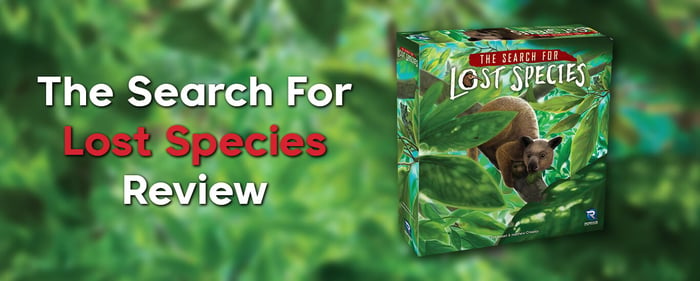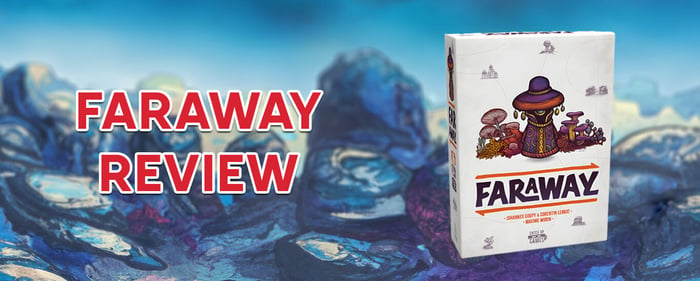Specifications
Categories: logic deduction, puzzle
Number of players: 1-4
Typical game time: 60-75 mins
Age range: 13+
I recently got the opportunity to play The Search for Lost Species. Having previously enjoyed The Search for Planet X, I was really excited to try it out. This feels like a direct sequel from Planet X, retaining much of the mechanics and feel of the game whilst bringing a completely new and engaging theme, along with a new way to interact with the board.
In case you have never heard of The Search for Planet X, I think it would be good to give you a short overview. Every once in a while you play something that is truly interesting and innovative, or just does what it sets out to do better than anything else. This is one of those games. In The Search for Planet X you play as astronomers hunting for a mysterious planet at the edge of our solar system. In the game, you have a number of actions that help you discover logic rules, clues and other useful information. This is managed through a well put together app that responds to your actions and helps you piece together what is located in each of the 16 night sky segments, eventually having enough information to find Planet X. Having previously not been that keen on companion apps, I had my reservations, but the game delivered a fantastic experience of logic deduction and problem solving.
The Search for Lost Species builds on that original game, taking some of those brilliant mechanics and improving the system via a lovely double sided board map. I think they have taken an already great gaming experience and made it even better!
Table of Contents
The Context
“Thousands of planets and animals have been discovered but haven't been seen for decades and could be on the brink of extinction. In order to save these species we must find them again.
The Search for Lost Species is a game about this real world search. You are scientists on an expedition to find one of these lost species. While there are lost species all over the world, this game focuses on several Lost species in Indonesia and Papua New Guinea.”
-From the Manual
The Goal
So, as the theme would suggest, the aim of the game is to correctly locate the lost species, which can be 1 of 6 species chosen at the beginning of the game. Alongside this, you are trying to identify the animals in each space on the map – there can only be one in each. At various points of the game you get an opportunity to report sightings and, if correct, bring you additional points towards final victory.
How Does It All Work?
In The Search for Lost Species you have a number of actions available to you, to help you in your search of the island represented on the board. To add a bit of variation, and the ability to change the game's difficulty, the board is double sided with two island variations, one slightly harder in its difficulty level than the other.
The board is one of the big changes from The Search for Planet X. In that game, the board depicted the night sky with 12 (or 18) sectors visible and you could choose any sector during your actions. In Lost Species, you are searching an island and moving your scientist around in order to complete your actions, surveying spaces and setting camera traps. Location on the board is important and can limit what actions you can take. Position and movement matter. I really like this change and it felt particularly on theme as you take your time, moving across the board to survey spaces on the island.
When you start the game you are given a note sheet. This becomes important as you research animals, uncover species locations, take notes on the outcomes of the actions you take, and keep track of what your opponent is doing. On this point though, if you're anything like me, you will sit there a little puzzled and spend far too much time trying to work out what they know!
At the start of the game, you already know some information. Each other animal on the island has a certain behaviour/logic in where they might be found in relation to other animals. This is the crux of the game, understanding the animals' logic rules. For example, the lory birds are always found in a diamond shape on the map. Four adjacent hexagons make up this shape, so once you have successfully located one bird you can start to deduce the locations of the others. In fact, you are provided with a lory token that can be used to overlay your notepad.
The cuscus is only ever one or two spaces from the next cuscus and the toad is always next to two truly empty spaces on the board. Then we have the python which is never found adjacent to a cuscus. Finally, we have the lost species itself, each one having its own unique logic rule.
As you work through the game you are trying to piece together the information you have against the logic rules you know. As you progress, more logic rules will be researched and uncovered helping you to narrow your search, eliminate certain animals from spaces and uncover possible lost species locations.
You will stare at that map until you have crossed through, rubbed out, changed your thinking, and decided the game is broken. Finally, it will click and you will feel a mixture of relief and joy as you realise the possible solution.
Make no mistake, this is a brain burner, but one that will give you great satisfaction.
The Companion App
As I previously mentioned, this may have put me off in the past, but having been encouraged to try Planet X, I knew how good this could be. The Search for the Lost Species can only be played through the free companion app provided by the people at Renegade Game Studios. But, before you switch off at this stage, wait, let me explain how good this is.
Firstly, the app is small in size and does not need data to run. In fact, it recommends you put your device into airplane mode to stop any distractions!
The app randomly generates your island every time you play, enabling great replayability. Each person can download the app separately and join your game with the unique game code or you can share a device and add multiple players to the game. It even comes with a fantastic solo mode with the turns of Tina, named after a great female explorer, played out through the app. For transparency, Tina is really good at this game and I lost to her. That's hard to admit!
On your turn you choose one of the 5 actions available to you - we will come back to these in a minute. Select the action and the locations in the app, and it will reveal to you some new information. This is then used to build the picture on your notepad. Using an app also means you have a full turn history to look back through if needed, which is so helpful.
The app is incredibly well built and easy to use and only enhances the gameplay of Lost Species.
The Gameplay
So before I give you some final thoughts, let me explain how you use the actions available to you and the way time passes in this game.
In this game, you have one scientist on the island and another one on a time track that runs around the edge of the board. Each action in the game takes a certain amount of time, which is represented by you moving your piece in that many spaces on the time track. Whoever is furthest back takes the next turn, meaning that sometimes you might end up taking back to back turns as you catch up.
With you on the time track is an expedition leader – each time they reach the back and take a turn various new information is revealed. Firstly, it is when the expedition leader goes that you confirm sightings, this is a moment when you select between 0-2 sighting tiles (you have one for every possible animal) and from behind a hidden screen place them face down in regions on the board. Later in the game you get to reveal those sightings again when the expedition leader hits a certain space and you gain points for correct sightings, more importantly it confirms to all either a correct animal or crosses an incorrect animal off. Finally, you get 2 research items published in the form of conferences that trigger when they get there which help you with new logic around the Lost Species.
On your turn you can take 1 of 5 actions. Visiting a town provides you with new logic information and enables you to pick up a town card providing you with a one shot ability or end game scoring mechanism. You can survey by boat or by foot, which enables you to travel a certain number of spaces and request information on an animal type. You will then get told how many of that type of animal you have passed, though not which spaces. You can set a camera trap. This gives you exact information about a space but is very costly in time. Finally, you can try and locate the lost species, which means identifying the correct space on the board as well as the correct information about 2 adjacent spaces. You can't just take a punt, well you can, but you would do well to guess all 3 bits right!
This is a really clever game which asks you to gather information, mapping out the possible species in the spaces you pass through whilst collecting new research on how the animals behave in relation to each other, building a working theory on where the lost species might be. All of this builds up to choosing the right moment to locate the lost species whilst taking the risk that, if you are wrong, others might get there first.
Final Thoughts?
I will say it straight away, I really enjoyed this game, I played it solo in the afternoon and convinced a friend to play it again that evening, and hilariously we both made huge errors by making the wrong assumption early on, which made it more challenging.
I love the way this game is designed and although there will be great logic deduction games out there I still haven't tried, this has got to be one of the best in the genre. I feel the app adds real value. It's well built and easy to use and creates a huge amount of replayability as it randomises the animal layout. Having 2 board sides and 6 different lost species to find, each with their own logic, also creates completely different game experiences. The way the game progresses and new logic information is revealed as you research and hear announcements brings lightbulb moments that send you furiously checking your previous choices and making new decisions on what might be in a location. You will also sit there at some point, not believing it is possible, and that the game must be broken, until you realise it was entirely user error! Well, that was our experience.
This game does require a lot of thinking though. Often you are trying to work through different possibilities and using your turns as efficiently as you can to help eliminate and identify animal locations. The sightings mechanic helps to keep this moving as you balance declaring sightings that will bring victory points with revealing space information to others. Your notepad will end up resembling that of a mad professor by the end of the evening as you have crossed out, circled, rubbed out, and taken notes all over it before you get to the end.
There is a small amount of player interaction, mainly, in trying to identify sightings before your opponents which ultimately also leads to sharing of information. This really is a race to solve the problem before the other teams of scientists get there first and take the glory.
Score 7.5 out of 10
-I would completely recommend this game to anyone looking to try something a bit different especially if you enjoy logic deduction puzzles or games that will give you a bit of a challenge. Happy to add this to my collection!
| Pros | Cons |
| Well designed, easy to use app | Limited player interaction |
| Really well worked through logic rules that build throughout the game | Can feel like quite a complex problem solver |
| Huge amount of replayability | You need to use an app to play the game |
| Eco friendly design | It can make your head hurt |
Eco Friendly
The designers have made an effort to use this game to highlight the work of Re:wild who actively raise awareness and seek to find lost species of animals around the world.
They have also created a game that is entirely environmentally friendly, wooden pieces, no plastic packaging, and even providing component envelopes instead of baggies. The entire production is done by a factory that uses eco-friendly decisions for their entire operation.
The manual also comes with facts about the challenge around the lost species of animals it focuses on as well as information on the location and animals used in the game which I think was a great touch and really interesting.
Check out The Search for Lost Species and the full collection of board games here at Gathering Games.








